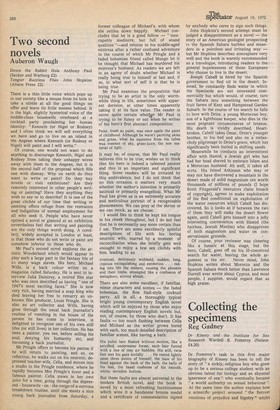Collecting the specimens
Reg Gadney
Dr Kinsey and the Institute for Sex Research Wardell B. Pomeroy (Nelson £4.20)
Dr Pomeroy's task in• this first major biography of Kinsey has been to tell the story of "a sickly, religious boy who grew up to be a serious college student with an obvious talent for biology and an abysmal ignorance of sex" who eventually became "a world authority on sexual behaviour ". At the same time the author explains how a scientific project aroused "the fiercest emotions of prejudice and bigotry" whilst
telling us what it was Kinsey found out about sex and what it all meant. Pomeroy is well placed to do so. He was one of Kinsey's closest friends and worked with the professor at Indiana University for thirteen years. Because so little of Kinsey's character and motives has been previously recorded, Pomeroy's detailed account is of particular interest.
Kinsey shared with his colleagues 'the grand design" of trying to find out "by means of face-to-face interviewing followed by statistical analysis of the facts . . . what people did sexually." What seems to have lain beneath his extraordinary persistence was a collector's passion. It began with stamps; it developed into an obsession with the gall wasp of which Kinsey collected more than four million specimens. Day lilies and irises came next and then the most significant of all: the 18,000 sex histories. These formed the basis of Kinsey's books Sexual Behaviour in the Human Male (1948) and Sexual Behaviour in the Human Female (1953). Never before had research into human behaviour been attempted on such a large scale. It revealed to an astounded American public that a third of all American males had at least one homosexual experience in their lives. It showed that two-thirds of all Americans engaged in pre-marital intercourse, 50 oer cent of the male subjects engaged in extra-marital intercourse whilst only 25 per cent of the females entertained themselves similarly. These and other revelations meant that the sexual behaviour of the Americans was rather more remarkable than they had previously led themselves to believe. Of course there followed debates about the validity of Kinsey's research methods. But these were overshadowed by the ferocity of the attacks launched against Kinsey by the armies of the American righteous. His researches had, it was argued, separated sex from emotion, love and morality: something which it hasn't exactly taken research to do for western society ever since. Pomeroy's quiet and reasonable account shows us that Kinsey never considered his brief to be the research of morality, love or emotion as such. It was true that he Privately censured moral repression of a blatant and stupid kind. However, others took it upon themselves publicly to censure Kinsey.
"Hey, Kinsey," wrote one critic, "all my women and men friends and I, think You're full of bull shit, and hope you rot In hell, which we figure you will in due time." Female stumped Billy Graham: "It is impossible to estimate the damage this book will do to the already deteriorating Morals of America." Pastor Wimbish of New York compared Kinsey to Nebuchadnezzar, a man who would lead the people
out into the fields to mingle with the cattle and become one with the beasts of • e jungle ". They were joined by thousands: Gorer and Mead, Reader's Digest and Niebuhr, Clare Boothe Luce and the Rockefeller Foundation, 150,000 Catholic Mothers of Indiana and four coeds from Florida who signed themselves "The Vic ious Virgins." Reg Gadney's new novel " SectraToriOra Tall Man" is to be published in November.

































 Previous page
Previous page